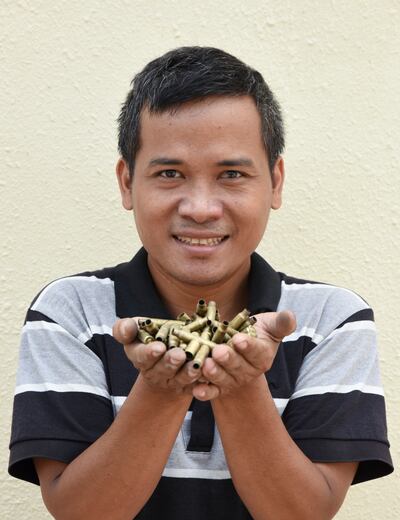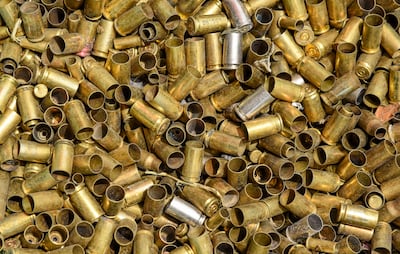Glimmering in the Cambodian sun, the custom-made hairpin held by designer Chantha Thoeun is laden with symbolism. This bronze piece depicts a rumduol, the graceful national flower of Cambodia. Amid the bleakest era in this country’s history, as Cambodia’s Khmer Rouge communist party committed genocide in the 1970s, the rumduol continued to bloom, offering rare displays of splendour amid a torrent of despair.

Thoeun, 40, now attempts to replicate this feat of nature by creating beauty from tragedy. He has no siblings, his mother is dead and his father was killed by the Khmer Rouge, which massacred about two million Cambodians. As an orphan, he was taught to become a blacksmith and now, paying homage to his parents and murdered countrymen, he turns old bullets and bombshells into jewellery.
“I want to highlight the plight of the Khmer people and what they have had to endure,” Thoeun says. “I believe it is a strong statement about my country and what people can do. Turning something negative that was used to kill millions of Khmer people, including my dad, into something of hope, strength and endurance.”
When I met Thoeun at his workshop in Phnom Penh, prior to the coronavirus pandemic, he was covered in sweat, flattening a piece of shrapnel with his hammer. His studio was basic. It was little more than a garage with a few tool benches and plastic chairs.

That is all Thoeun needs, though, he says. Because what makes his products special is not extraordinary intricacy or rare materials. Rather, their significance stems from the deep history and moving personal tale embedded in each piece. Many of his customers are attracted by the remarkable backstory of his company, Angkor Bullet Jewellery.
It is a tale that has its roots in 1975. That was when Cambodian society was ripped apart by the Khmer Rouge, which in April that year seized control of the nation. Led by infamous dictator Pol Pot, this revolutionary party aimed to reset Cambodia to what it termed “Year Zero”, which meant dismantling its religious, social and financial systems and returning the people to a basic, agricultural lifestyle.
Anyone deemed to represent even a remote threat to this strategy was executed. Artists, academics, authors, journalists, musicians, politicians, monks, businessmen – the kill list was so long the Khmer Rouge never reached its end. By 1979, this murder machine was operating at full capacity. Then, finally, the homicidal spree came to an end when Vietnam conquered Phnom Penh in January that year and sent the Khmer Rouge scurrying into the jungle.

Two years later, Thoeun was born into a nation trying to heal gaping wounds. In 1985, when he was 4, his life changed. He was living with his parents in Pursat Province, 100 kilometres north-west of the Cambodian capital. He was too young to properly comprehend what happened. His mother became ill, with her condition deteriorating, until, one day, Thoeun’s father told him she was now living with the gods.
All the while, the Khmer Rouge hadn’t disappeared. Instead, its members had scattered and resurfaced in different parts of the country. They weren’t entirely finished with meting out misery. In 1989, a notorious Khmer Rouge soldier murdered Thoeun’s father. He was now an orphan.
“I still remember the day my father passed away,” Thoeun says. “I remember begging him to wake up as I did not realise he had been killed. I wept and wept.”

Fortunately for Thoeun, the Cambodians are a resolute and generous people. When he was 12, a local orphanage helped him learn the basics of metalwork. Years later, he slowly saved enough money to attend a design school. Then, at age 19, he fused the physicality of blacksmithing with the cerebral aspect of design to begin crafting his own jewellery.
Keen to create more than merely attractive pieces, he sought to imbue his products with meaning. Using spent bullets and bombs as his materials was a natural fit. By 2010 he had enough capital to open his own business. Now, Angkor Bullet Jewellery products are sold online to buyers across the world and Thoeun runs an expanding operation alongside several staff and his wife, Kolpheany, with whom he has two children.
Having reached this point owing partly to the charity of others, he is now giving back to his community. His staff are made up of disabled and disadvantaged people. Thoeun and his wife, who is also a jewellery designer and blacksmith, have passed on their skills to these employees.

Together, the team at Angkor Bullet Jewellery make rings, necklaces, bracelets, anklets and hairpins. Their designs often incorporate symbols of Cambodia, such as the rumduol flower or ancient Khmer motifs. They also create jewellery in European styles based on the requests of their overseas clients.
Prior to the pandemic, Thoeun regularly welcomed foreign tourists into his studio to watch his artisans work and to order custom-made pieces. Now, international tourism has disappeared from Cambodia.
Thoeun says that while this has had an impact on his business, he has managed to stay afloat through his local client base and by selling items online to foreign customers. He has also used some of his own savings to support his staff during the pandemic. Decades after the Khmer Rouge decimated Cambodia and destroyed Thoeun’s family, he is now a community leader, guiding vulnerable people through a global catastrophe.
“I am further inspired today for the love and wellbeing of my family and this motivates me to help and support others in my community,” he says. “I also love that I have the ability to recycle or upcycle a bullet or a bombshell that would otherwise not be reused and give it a new life.”




